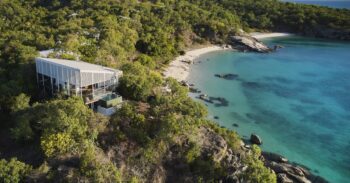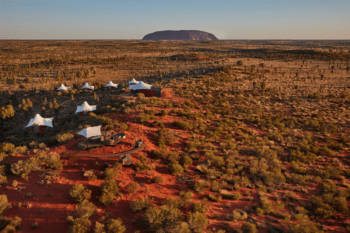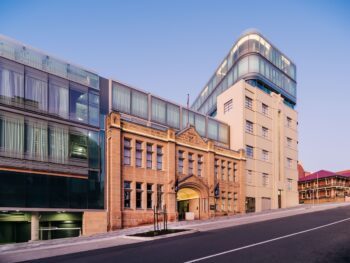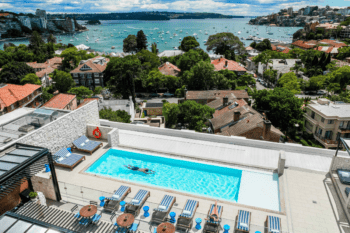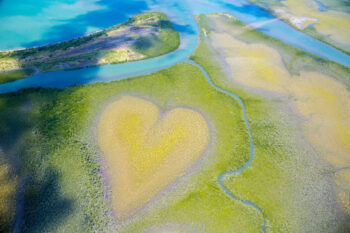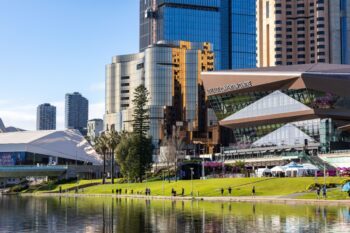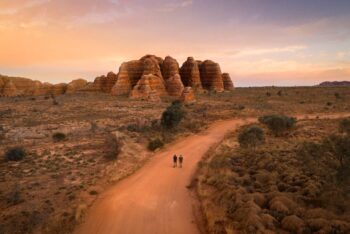
There’s a friendly debate going on aboard the other tender boat as to who spotted them first, but by the time I’ve got my camera out, it’s too late – the timid chartreuse parrots have already flown away.
It’s the final day of our six-night expedition cruise in Port Davey, a sliver of coastal countryside in the vast Tasmanian Wilderness World Heritage Area.
I am trying to take a photo of the critically endangered Orange-bellied Parrots (OBPs) before they migrate from Tasmania’s south-west shores to venture north and scatter across South Australia. With less than 200 OBPs left in the wild and being notoriously flighty, seeing them anywhere but their nesting grounds in Port Davey is not a bet worth taking.
Our skipper, Pieter van der Woude, has brought us back to Melaleuca for one last chance to spot these rare birds.
Pieter – founder of On Board, captain of the Odalisque III, experienced abalone diver and retired police officer – has one more fascinating feather in his proverbial cap: he’s an avifauna fan. “You’re into birds?” is the first thing Pieter asks me after I have dropped off my bags in my coastal-inspired cabin aboard the Odalisque III, an elegant 24-metre catamaran built in Hobart that moors at the confluence of environmentally sustainable design and boutique on-water accommodation. As soon as I confirm I’m a kindred birder, it becomes just one of the many highlights during my visit to one of the most unique luxury adventures in Australia.
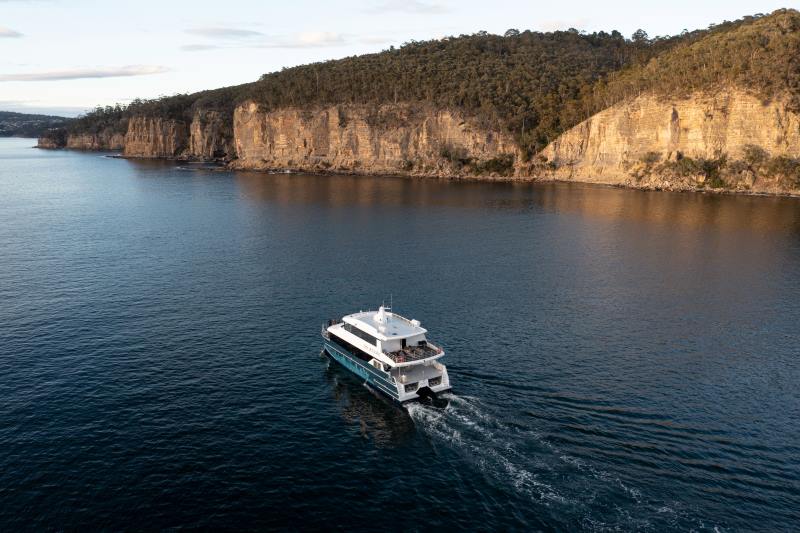
Odalisque III is the latest addition to the Luxury Lodges of Australia collection, which includes fellow Tasmanian superstar Saffire Freycinet and True North in The Kimberley. Purpose-built to navigate the niches of Port Davey Marine Reserve, her expedition is an intimate initiation to a UNESCO-recognised natural wonder – one of only two locations in the entire world that satisfies 7 of the 10 classification criteria. It is a secret realm of quartzite mountains, ancient forests and oscillating waterways where living fossils like King’s Holly, a plant dating back over 40,000 years, can grow undisturbed. Since it is accessible only by air or sea, Port Davey has also managed to waylay excessive visitor numbers; a boon for pristine wilderness lovers.
The Odalisque III is Pieter’s ode to the island state. Every aspect of her home-grown Hobart build incorporates local materials so the onboard experience feels like a natural extension to the wild world beyond. Wide windows line the vessel port-to-starboard, inviting views of tannin-tinted waves and tree-lined beaches into the spacious suites and shared spaces. The rare Huon pine also features in the grand gold-hued timber helm and more subtly as carved housekeeping room signs. Even entering my cabin “teralina” (named after Eaglehawk Neck’s dual name in the palawa kani language), its woodsy, vetiver scent is a breath of temperate rainforest to match linens printed with illustrations of Tasmanian botanicals.
Tasmania isn’t only found in Odalisque III’s timbers and between pages of the onboard library books – it’s also chopped, charred and served up as the hero of each culinary creation by On Board head chef Courtney Drew.
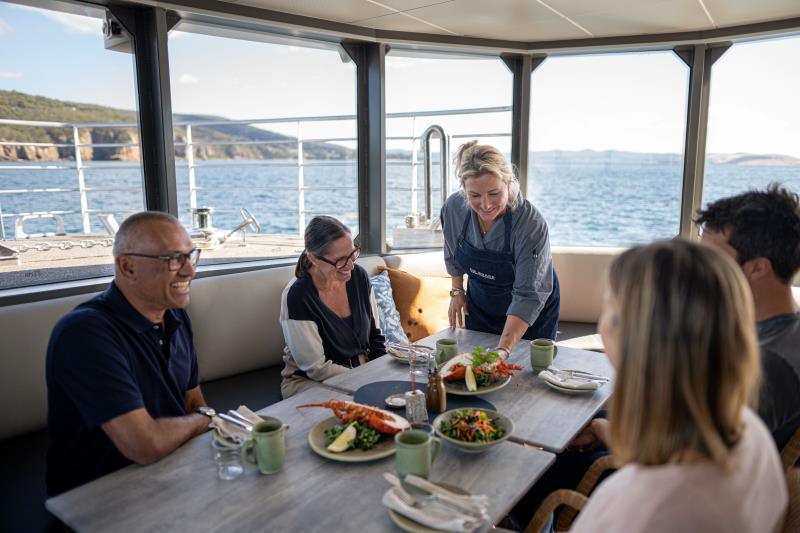
Every meal served on Odalisque III is a casual affair and guests can attend in sandals or even bare feet. Gathered around the Huon pine dining table that night, we swap stories between bites of an opulent “Surf & Turf” platter: strips of Cape Grim hanger steak alongside smoky charred crayfish (a deceptively understated nickname for the succulent Southern Rock Lobster) and the tang of chimichurri.
As the days continue, the head chef makes sure that no matter how deep we are in this sprawling segment of World Heritage area that encompasses almost a quarter of Tasmania, we never go without. After several stretches of bushbashing through copses of Smithton peppermint eucalypts and tea trees, I am resting at the sandbank of Hannant Inlet watching trickles of freshwater flow into the enormous blue ocean. There are only the six of us on the beach and in the immense quietude. Suddenly, our guide Paul breaks out the white chocolate and raspberry muffins Courtney baked that morning. It’s an unexpected slice of home in Port Davey.
Sunsets and fine wine
Our itinerary often has to adapt to the whims of the weather. Strong winds may mean the tinnies are in for a bumpy ride, but it also encourages freewheeling shearwaters to take to the sky for our viewing pleasure and curious dolphins to inspect the vessel while we’re stationary. Pieter is well-versed in interpreting the conditions after years spent on these waters. “Here’s my old office,” he says, gesturing to the tiny islands of Sugarloaf Rock and the East Pyramids where he once dove for abalone beyond the coast of Stephens Bay. It’s a heck of a view, as offices go. Not only of the ever-changing seascape, but the sand dunes host towering hills of opalescent shells that glitter under the emerging sun – these distinct deposits are cultural living sites, historic remnants of the hunting and gathering practices of the south west First Nations peoples, which includes the Needwonnee, Ninene and Lowreenne nations.
For all the isolation of our surroundings, there’s never a lonely moment on the Odalisque III. There are two universals that always bring our convivial group together: sunsets and wine. The first night the clouds
clear enough for a hint of orange to tint the darkening sky, everyone’s cameras suddenly appear out of nowhere. By now, our dinner plates of slow-braised wallaby shoulder in a pinot, pepperberry and blueberry gravy have been cleared to rave reviews. For the next forty minutes, chatter is tabled for laughter and posing on the bow deck as we try to capture the vivid Tasmanian sunset.
After dozens of photos are snapped, we reconvene inside for drinks. Spoilt for choice with names like House of Arras to the boutique Attunga Ridge, the one that catches my eye is Lake Barrington Estate’s Dornfelder – a robust red that steps boldly away from the lighter drops that Tasmania is famous for. On board with me is the estate’s grower, Travis Klerck, one of many who have left the mainland to try their hand at starting a vineyard; in his case, near Cradle Mountain.
When I ask him why he chose Tasmania specifically, Travis says it’s a combination of the cool climate, community passion and “an appreciation for the local touch”, all of which encourages would-be vintners.
Perhaps that’s how the Orange-bellied Parrots feel when they make their summer sojourn to the buttongrass plains of Southwest National Park in Tasmania.
Thanks to the minimal footprint left by expeditions like the Odalisque III and the passion of local volunteers, this natural wonder is a frontier of possibility, a chance at renewal in a landscape untouched by modern civilisation.
We never get to the bottom of who saw the OBPs first, but we can all agree that it’s been a gift to see them at all.
This article was originally featured in the third issue of Dream by Luxury Escapes magazine. Get your copy here.

Feature image: Lean Timms.
